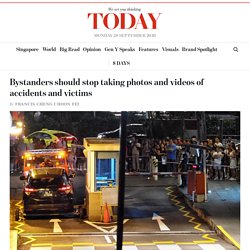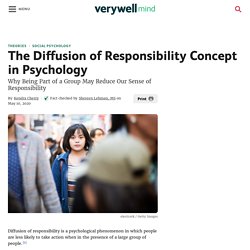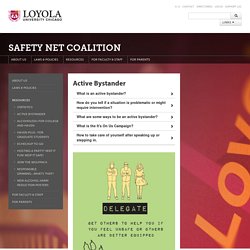

What Is the Bystander Effect? If you witnessed an emergency happening right before your eyes, you would certainly take some sort of action to help the person in trouble, right?

While we might all like to believe that this is true, psychologists suggest that whether or not you intervene might depend upon the number of other witnesses present. What Is the Bystander Effect? The term bystander effect refers to the phenomenon in which the greater the number of people present, the less likely people are to help a person in distress. When an emergency situation occurs, observers are more likely to take action if there are few or no other witnesses. Being part of a large crowd makes it so no single person has to take responsibility for an action (or inaction). In a series of classic studies, researchers Bibb Latané and John Darley found that the amount of time it takes the participant to take action and seek help varies depending on how many other observers are in the room. The Kitty Genovese Case. Are We Victims Of "Bystander Effect"?
TODAYonline. I refer to the news reports of the fatal traffic accident on Sunday (Dec 29) at Lucky Plaza.

I applaud the Good Samaritans who unselfishly helped to lift up the car, pulled the victims out and attended to them. These are acts of true heroism. They encourage us to lend help to accident victims when needed and show that there are still compassionate people who don’t respond to accidents by whipping out their phones first to take videos and photos to circulate to their friends. In Sunday’s incident, one of the first things a bystander could do was to rush to the nearby Mount Elizabeth Hospital Accident and Emergency Department to seek help, as it would have the necessary medical equipment and trauma specialists on duty. This was crucial as the Singapore Civil Defence Force ambulances would take some time to arrive and the accident victims needed immediate medical attention and first aid.
But this cannot be at the expense of not rendering help to victims. Khaseen Morris: Teen held for killing that bystanders filmed. Image copyright Nassau County Police A New York teenager has been charged with the fatal stabbing of a 16-year-old boy whom bystanders filmed bleeding to death.

Tyler Flach, 18, is accused of second-degree murder in the deadly after-school brawl that broke out not far from the victim's Long Island school. Police said that most of the "50, 60, 70" kids who witnessed the attack on Khaseen Morris did nothing to stop it. "That's egregious," said Detective Lt Stephen Fitzpatrick. "Kids stood here and didn't help Khaseen," Lt Fitzpatrick said.
Police were called to a row of shops near Oceanside High School in Nassau County on Monday afternoon. The 21st century bystander effect happens every day online. If you’re going to fall, injure yourself and need help, where is a good place to do it?

Should you choose a busy thoroughfare or a deserted backstreet? Statistics and experiments in social psychology will tell you that if you need help, you should avoid dropping in a busy street, even if hundreds of people are passing through. This is because of a phenomenon known as the bystander effect. The more individuals gathered in one place, the less chance there is of one of them coming to the aid of a person in need.
When an emergency situation occurs, it’s more likely that someone will come to the rescue if there are fewer or almost no witnesses. And in the 21st century, when our thoroughfares are online and on social networks, millions of people are effectively passing each other by every minute. Social Experiment: Diffusion of Responsibility. THE BYSTANDER EFFECT. Is the Bystander Effect Real? Diffusion of Responsibility: Definition and Examples in Psychology.
How Diffusion of Responsibility Affects Group Behavior. Diffusion of responsibility is a psychological phenomenon in which people are less likely to take action when in the presence of a large group of people.1 For example, imagine that you are in a large city on a bustling street.

You notice a man fall to the ground and start convulsing as if having a seizure. Many people turn and look at the man, but no one moves to help or call for medical assistance. Why? Because there are so many people present, no one person feels pressured to respond. Pluralistic Ignorance (SOCIAL PSYCHOLOGY) - iResearchNet. Pluralistic Ignorance Definition Pluralistic ignorance occurs when people erroneously infer that they feel differently from their peers, even though they are behaving similarly.

Active bystander. Be an active bystander. Do not stand by, step up! Active Bystander: Safety Net Coalition: Loyola University Chicago. Be direct.

Address the person being targeted or the problematic behavior directly. Things you can say to the person being targeted: “Do you need help?” “Do you want me to call someone for you?” “What can I do to help you?” “Can I walk you home?” Things you can say to the person acting not so good: “What you said earlier really bothered me...” Removing someone from a risky situation works as a way to directly intervene too. Distract. Delegate. Breaking the silence - preventing harassment and sexual misconduct. Be an Active Bystander We can all be bystanders. Every day events unfold around us. At some point, we will register someone in danger. When this happens, we will decide to do or say something (and become an active bystander), or to simply let it go (and remain a passive bystander).
When we intervene, we signal to the perpetrator that their behaviour is unacceptable.